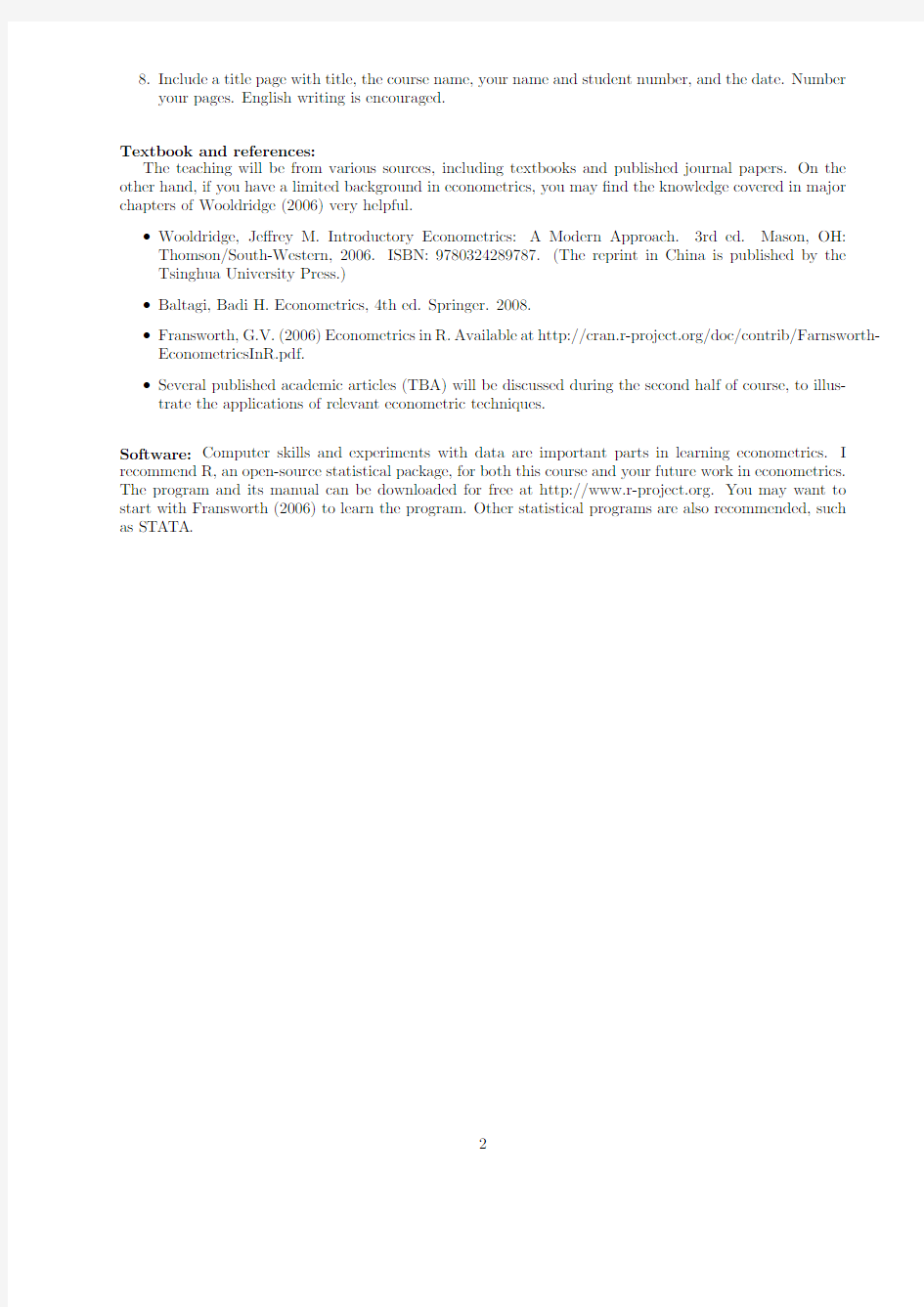econometrics(master)


School of International Business Administration
Shanghai University of Finance and Economics
Applied Econometrics(Graduate)
2011Fall
Instructor:Ju,Heng
Email:hengju@https://www.wendangku.net/doc/77394822.html,
Tel:6590-3149
Teaching:Friday,8:55am–11:30am,@Rm.4304
O?ce hours:after class and by email appointment
Teaching Assistant:Mr.Wei,Lian-chi
Email:LCWEI002@https://www.wendangku.net/doc/77394822.html,
Objective:After reviewing the basic econometric theory of linear models,in particular the Ordinary Least Squares(OLS),the course will introduce the popular econometric methodologies for independent research in cross-sectional and panel data.The applied?elds include industrial economics,international trade and marketing.Both reduced-form and structural approaches will be covered.Toward the end,merger review in antitrust analysis will be studied.
Evaluation:The overall grade is comprised of three parts:
1.Assignments,20%.
2.Final exam,40%.
3.Term paper,40%.
Term paper:
1.Each student is expected to write a paper(within20pages and don’t feel shy if your analysis is solid
but the paper is short,double spaced,typed)studying an empirical issue on your own choice.The major objective is to practice the learnt econometric skills in analyzing real market data.The data is preferable to be micro data,such as household,product market,international trade,etc.,unless your major?eld is the international?nance.
2.You can discuss the methodologies and?ndings in literature,but not necessary.The compulsory parts
include a.)descriptions of the data source and summary statistics;b.)empirical model and justi?cation of the model;and,c.)empirical results and discussions.Some may?nd useful to have a theoretical model to motivate the choice of empirical method.
3.You may want to discuss with your thesis advisor for possible data source or even an interesting topic.
4.The writing has to be original.Plagiarism is NOT allowed.
5.The format of references,tables,?gures and equations has to follow academic standard.Check pub-
lished journal articles on how to present them in your paper.
6.The grade is based on the overall integrity of the paper and the sophistication of the empirical analysis.
For example,a sole application of OLS method without further discussion of possible data issue is considered to be unacceptable.
7.The deadline is5pm,the?rst day of the second semester.No late submission will be accepted.You
MUST submit your printed-out paper into the box beside my o?ce.Email submission is NOT accepted.
8.Include a title page with title,the course name,your name and student number,and the date.Number
your pages.English writing is encouraged.
Textbook and references:
The teaching will be from various sources,including textbooks and published journal papers.On the other hand,if you have a limited background in econometrics,you may?nd the knowledge covered in major chapters of Wooldridge(2006)very helpful.
?Wooldridge,Je?rey M.Introductory Econometrics:A Modern Approach.3rd ed.Mason,OH: Thomson/South-Western,2006.ISBN:9780324289787.(The reprint in China is published by the Tsinghua University Press.)
?Baltagi,Badi H.Econometrics,4th ed.Springer.2008.
?Fransworth,G.V.(2006)Econometrics in R.Available at https://www.wendangku.net/doc/77394822.html,/doc/contrib/Farnsworth-EconometricsInR.pdf.
?Several published academic articles(TBA)will be discussed during the second half of course,to illus-trate the applications of relevant econometric techniques.
Software:Computer skills and experiments with data are important parts in learning econometrics.I recommend R,an open-source statistical package,for both this course and your future work in econometrics.
The program and its manual can be downloaded for free at https://www.wendangku.net/doc/77394822.html,.You may want to start with Fransworth(2006)to learn the program.Other statistical programs are also recommended,such
as STATA.
2
Applied Econometrics(Graduate),2011Fall
Course Outline
1.Background and review of probability/statistics
?Probability,distribution,and expectation
?Statistical inference:sampling distribution and inference,the Central Limit Theorem(Asymptotic
distribution of the sample mean),con?dence intervals
2.Regression basics:OLS and its modi?cations
?Gauss-Markov theorem
?Asymptotic distribution of the sample slope
?Residuals,?tted values and goodness of?t
?Regression,causality and control
?Functional form and Dummy variables
?Inference problems
–Heteroscedasticity,Linear Probability Models
–Serial Correlation in time series,Durbin-Watson test
?Instrumental variables
3.Limited Dependent Variable Models
?Probit and Logit models
?Tobin model
?Poisson model
?Ordered Probit model
4.Panel Data Methods
?Fixed E?ects
?Random E?ects
5.(optional)Topics on Time Series Data
?Serial Correlation,Stationarity
?Granger causality
?Co-integration and Error Correction Model
6.Simultaneous equations models
?Motivation and identi?cation
?Estimation
7.Application:Demand Functions and Competition Models
?Linear,Log-linear,Almost Ideal Demand System(AIDS),Multi-level Demand,Logit and Nested-
Logit Discrete Choice Models
?Cournot model,production di?erentiation models
?Genesove,D.and W.Mullin,(1998).Testing Static Oligopoly Models:Conduct and Cost in the
Sugar Industry,1890–1914.RAND Journal of Economics29(2),pp.355–377.
?Berry,S.,(1994).Estimating Discrete-Choice Models of Product Di?erentiation.RAND Journal
of Economics25(2),pp.242–262.
?Ashenfelter,O.,D.Ashmore,J.Baker,S.Gleanson and D.Hosken,(2004).Econometric Meth-
ods in Staples.Princeton Law Public A?airs Paper No.04-007.Available for download at
https://www.wendangku.net/doc/77394822.html,/abstract=529144
3
